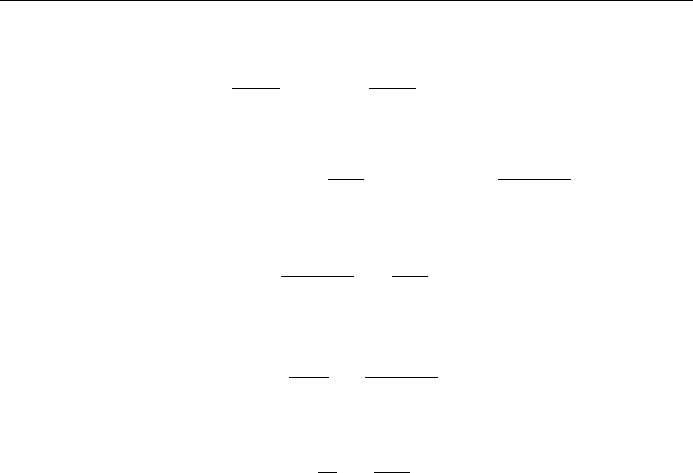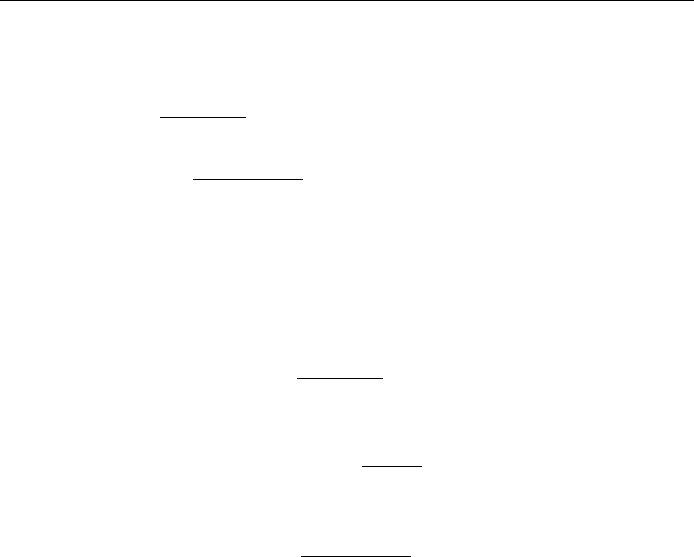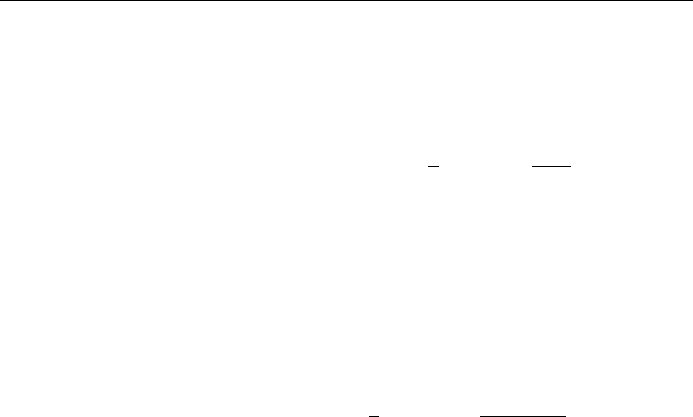Chow T.L. Mathematical Methods for Physicists: A Concise Introduction
Подождите немного. Документ загружается.


or
Lx
n
n
p
Lx
nÿ1
from which we may obtain for n > 1
Lx
nÿ1
n ÿ 1
p
Lx
nÿ2
:
Iteration of this process yields
Lx
n
nn ÿ 1n ÿ 22 1
p
n
Lx
0
:
By (1) above we have
Lx
0
L11=p:
Hence we ®nally have
Lx
n
n!
p
n1
; p > 0:
(3) f xe
ax
, where a is a real constant.
Le
ax
Z
1
0
e
ÿpx
e
ax
dx
1
p ÿ a
;
where p > a for convegence. (For details, see Example 9.1. )
(4) f xsin ax, where a is a real constant.
Lsin ax
Z
1
0
e
ÿpx
sin axdx:
Using
Z
uv
0
dx uv ÿ
Z
vu
0
dx with u e
ÿpx
; dv ÿdcos ax=a;
and
Z
e
mx
sin nxdx
e
mx
m sin nx ÿ n cos nx
n
2
m
2
(you can obtain this simply by using integration by parts twice) we obtain
Lsin ax
Z
1
0
e
ÿpx
sin axdx
e
ÿpx
ÿp sin ax ÿ a cos ax
p
2
a
2
1
0
:
Since p is positive, e
ÿpx
! 0asx !1, but sin ax and cos ax are bounded as
x !1, so we obtain
Lsin ax0 ÿ
10 ÿ a
p
2
a
2
a
p
2
a
2
; p > 0:
376
THE LAPLACE TRANSFORMATION

(5) f xcos ax, where a is a real constant.
Using the result
Z
e
mx
cos nxdx
e
mx
m cos nx n sin mx
n
2
m
2
;
we obtain
Lcos ax
Z
1
0
e
ÿpx
cos axdx
p
p
2
a
2
; p > 0:
(6) f xsinh ax, where a is a real constant.
Using the linearity property of the Laplace transform operator L, we obtain
Lcosh ax L
e
ax
e
ÿax
2
1
2
Le
ax
1
2
Le
ÿax
1
2
1
p ÿ a
1
p a
p
p
2
ÿ a
2
:
(7) f xx
k
, where k > ÿ1.
By de®nition we have
Lx
k
Z
1
0
e
ÿpx
x
k
dx:
Let px u, then dx p
ÿ1
du; x
k
u
k
=p
k
, and so
Lx
k
Z
1
0
e
ÿpx
x
k
dx
1
p
k1
Z
1
0
u
k
e
ÿu
du
ÿk 1
p
k1
:
Note that the integral de®ning the gamma function converges if and only if
k > ÿ1.
The following example illustrates the calculation of inverse Laplace transforms
which is equally important in solving diÿerential equations.
Example 9.3
Find
a L
ÿ1
5
p 2
; b L
ÿ1
1
p
s
; s > 0 :
Solution:
a L
ÿ1
5
p 2
5L
ÿ1
1
p 2
:
377
LAPLACE TRANSFORMS OF ELEMENTARY FUNCTIONS

Recall Le
ax
1=p ÿ a, hence L
ÿ1
1=p ÿ a e
ax
. It follows that
L
ÿ1
5
p 2
5L
ÿ1
1
p 2
5e
ÿ2x
:
(b) Recall
Lx
k
Z
1
0
e
ÿpx
x
k
dx
1
p
k1
Z
1
0
u
k
e
ÿu
du
ÿk 1
p
k1
:
From this we have
L
x
k
ÿk 1
"#
1
p
k1
;
hence
L
ÿ1
1
p
k1
x
k
ÿk 1
:
If we now let k 1 s, then
L
ÿ1
1
p
s
x
sÿ1
ÿs
:
Shifting (or translation) theorems
In practical applications, we often meet functions multiplied by exponential fac-
tors. If we know the Laplace transform of a function, then multiplying it by an
exponential factor does not require a new computation as shown by the following
theorem.
The ®rst shifting theorem
If Lf xFp; p > b ; then Le
at
f x Fp ÿ a; p > a b.
Note that Fp ÿ a denotes the function Fp `shifted' a units to the right.
Hence the theorem is called the shifting theorem.
The proof is simple and straightforward. By de®nition (9.1) we have
Lf x
Z
1
0
e
ÿpx
f xdx Fp:
Then
Le
ax
f x
Z
1
0
e
ÿpx
fe
ax
f xgdx
Z
1
0
e
ÿpÿax
f xdx Fp ÿ a:
The following examples illustrate the use of this theorem.
378
THE LAPLACE TRANSFORMATION

Example 9.4
Show that:
a Le
ÿax
x
n
n!
p a
n1
; p > ÿa;
b Le
ÿax
sin bx
b
p a
2
b
2
; p > ÿa:
Solution: (a) Recall
Lx
n
n!=p
n1
; p > 0;
the shifting theorem then gives
Le
ÿax
x
n
n!
p a
n1
; p > ÿa:
(b) Since
Lsin ax
a
p
2
a
2
;
it follows from the shifting theorem that
Le
ÿax
sin bx
b
p a
2
b
2
; p > ÿa:
Because of the relationship between Laplace transforms and inverse Laplace
transforms, any theorem involving Laplace transforms will have a corresponding
theorem involving inverse Lapace transforms. Thus
If L
ÿ1
Fpf x; then L
ÿ1
Fp ÿ ae
ax
f x:
The second shifting theorem
This second shifting theorem involves the shifting x variable and states that
Given Lf x Fp, where f x0 for x < 0; and if gxf x ÿ a,
then
Lgx e
ÿap
Lf x:
To prove this theorem, let us start with
FpLfx
Z
1
0
e
ÿpx
f xdx
from which it follows that
e
ÿap
Fpe
ÿap
Lfx
Z
1
0
e
ÿpxa
f xdx:
379
SHIFTING (OR TRANSLATION) THEOREMS

Let u x a, then
e
ÿap
Fp
Z
1
0
e
ÿpxa
f xdx
Z
1
0
e
ÿpu
f u ÿ adu
Z
a
0
e
ÿpu
0 du
Z
1
a
e
ÿpu
f u ÿ adu
Z
1
0
e
ÿpu
gudu Lgu:
Example 9.5
Show that given
f x
x for x 0
0forx < 0
;
and if
gx
0; for x < 5
x ÿ 5; for x 5
then
Lgx e
ÿ5p
=p
2
:
Solution: We ®rst notice that
gxf x ÿ 5:
Then the second shifting theorem gives
Lgx e
ÿ5p
Lxe
ÿ5p
=p
2
:
The unit step function
It is often possible to express various discontinuous functions in terms of the unit
step function, which is de®ned as
Ux ÿ a
0 x < a
1 x a
:
Sometimes it is conven ient to state the second shifting theorem in terms of the
unit step function:
If f x0 for x < 0 and Lf x Fp, then
LUx ÿ af x ÿ a e
ÿap
Fp:
380
THE LAPLACE TRANSFORMATION

The proof is straightforward:
LUx ÿ af x ÿ a
Z
1
0
e
ÿpx
Ux ÿ af xÿdx
Z
a
0
e
ÿpx
0 dx
Z
1
a
e
ÿpx
f x ÿ adx:
Let x ÿ a u, then
LUx ÿ af x ÿ a
Z
1
a
e
ÿpx
f x ÿ adx
Z
1
a
e
ÿpua
f udu e
ÿap
Z
1
a
e
ÿpu
f udu e
ÿap
Fp:
The corresp onding theorem involving invers e Laplace transforms can be stated as
If f x0 for x < 0 and L
ÿ1
Fp f x, then
L
ÿ1
e
ÿap
Fp Ux ÿ af x ÿ a :
Laplace transform of a periodic function
If f x is a periodic function of period P > 0, that is, if f x Pf x, then
Lf x
1
1 ÿ e
ÿpP
Z
P
0
e
ÿpx
f xdx:
To prove this, we assume that the Laplace transform of f x exists:
Lf x
Z
1
0
e
ÿpx
f xdx
Z
P
0
e
ÿpx
f xdx
Z
2P
P
e
ÿpx
f xdx
Z
3P
2P
e
ÿpx
f xdx :
On the right hand side, let x u P in the second integral, x u 2P in the
third integral, and so on, we then have
Lfx
Z
P
0
e
ÿpx
f xdx
Z
P
0
e
ÿpuP
f u Pdu
Z
P
0
e
ÿpu2P
f u 2Pdu :
381
LAPLACE TRANSFORM OF A PERIODIC FUNCTION

But f u Pf u; f u 2Pf u; etc: Also, let us replace the dummy
variable u by x, then the above equation becomes
Lfx
Z
P
0
e
ÿpx
f xdx
Z
P
0
e
ÿpxP
f xdx
Z
P
0
e
ÿpx2P
f xdx
Z
P
0
e
ÿpx
f xdx e
ÿpP
Z
P
0
e
ÿpx
f xdx e
ÿ2pP
Z
P
0
e
ÿpx
f xdx
1 e
ÿpP
e
ÿ2pP
Z
P
0
e
ÿpx
f xdx
1
1 ÿ e
ÿpP
Z
P
0
e
ÿpx
f xdx:
Laplace transforms of derivatives
If f x is a continuous for x 0, and f
0
x is piecewise continuous in every ®nite
interval 0 x k, and if jf xj Me
bx
(that is, f x is of exponential order),
then
Lf
0
x pL f xÿf 0; p > b:
We may employ integration by parts to prove this result:
Z
udv uv ÿ
Z
vdu with u e
ÿpx
; and dv f
0
xdx;
Lf
0
x
Z
1
0
e
ÿpx
f
0
xdx e
ÿpx
f x
1
0
ÿ
Z
1
0
ÿpe
ÿpx
f xdx:
Since jf xj Me
bx
for suciently large x, then jf xe
ÿpx
jMe
bÿp
for su-
ciently large x.Ifp > b, then Me
bÿp
! 0asx !1; and e
ÿpx
f x!0as
x !1. Next, f x is continuous at x 0, and so e
ÿpx
f x!f 0 as x ! 0.
Thus, the desired result follows:
Lf
0
x pLf x ÿ f 0; p > b:
This result can be extended as follows:
If f x is such that f
nÿ1
x is continuous and f
n
x piecewise continuous in
every interval 0 x k and furthermore, if f x; f
0
x; ...; f
n
x are of
exponential order for 0 > k, then
Lf
n
x p
n
Lf x ÿ p
nÿ1
f 0ÿp
nÿ2
f
0
0ÿÿf
nÿ1
0:
Example 9.6
Solve the initial value problem:
y
00
y 0; y0y
0
00; and f t0fort < 0 but f t1fort 0:
382
THE LAPLACE TRANSFORMATION

Solution: Note that y
0
dy=dt. We know how to solve this simple diÿerential
equation, but as an illustration we now solve it using Laplace transforms. Taking
both sides of the equation we obtain
Ly
00
LyL1; Lf L1:
Now
Ly
00
pLy
0
ÿy
0
0pfpLyÿy0g ÿ y
0
0
p
2
Lyÿpy0ÿy
0
0
p
2
Ly
and
L11=p:
The transformed equation then becomes
p
2
LyLy1=p
or
Ly
1
pp
2
1
1
p
ÿ
p
p
2
1
;
therefore
y L
ÿ1
1
p
ÿ L
ÿ1
p
p
2
1
:
We ®nd from Eqs. (9.6) and (9.10) that
L
ÿ1
1
p
1 and L
ÿ1
p
p
2
1
cos t:
Thus, the solution of the initial problem is
y 1 ÿ cos t for t 0; y 0 for t < 0:
Laplace transforms of functions de®ned by integrals
If gx
R
x
0
f udu, and if LfxFp, then LgxF p=p.
Similarly, if L
ÿ1
Fpf x, then L
ÿ1
Fp =pgx:
It is easy to prove this. If gx
R
x
0
f udu, then g00; g
0
xf x. Taking
Laplace transform, we obtain
Lg
0
x Lf x
383
FUNCTIONS DEFINED BY INTEGRALS

but
Lg
0
x pLgx ÿ g0pL g x
and so
pLgx Lf x; or Lgx
1
p
Lfx
Fp
p
:
From this we have
L
ÿ1
Fp= pgx:
Example 9.7
If gx
R
u
0
sin au du, then
Lgx L
Z
u
0
sin au du
1
p
L sin au
a
pp
2
a
2
:
A note on integral transformations
A Laplace transform is one of the integral transformations. The integral trans-
formation T f x of a function f x is de®ned by the integral equation
Tfx
Z
b
a
f xKp; xdx F p; 9:6
where Kp; x, a known function of p and x, is called the kernel of the transfor-
mation. In the application of integral transformations to the solution of bound-
ary-value problems, we have so far made use of ®ve diÿerent kernels:
Laplace transform: Kp; xe
ÿpx
,anda 0; b 1:
Lf x
Z
1
0
e
ÿpx
f xdx p:
Fourier sine and cosine transforms: Kp ; xsin px or cos px, and
a 0 ; b 1:
Ff x
Z
1
0
f x
sinpx
cospx
dx F p:
Complex Fourier transform: Kp; xe
ipx
; and a ÿ1, b ÿ1:
Ff x
Z
1
ÿ1
e
ipx
f xdx Fp:
384
THE LAPLACE TRANSFORMATION

Hankel transform: Kp; xxJ
n
px; a 0; b 1, where J
n
px is the
Bessel function of the ®rst kind of order n:
Hf x
Z
1
0
f xxJ
n
xdx Fp:
Mellin transform: Kp; xx
pÿ1
,anda 0; b 1:
Mf x
Z
1
0
f xx
pÿ1
dx Fp:
The Laplace transform has been the subject of this chapter, and the Fouier
transform was treated in Chapter 4. It is beyond the scope of this book to include
Hankel and Mellin transformations.
Problems
9.1 Show that:
(a) e
t
2
is not of exponential order as x !1.
(b) sin e
t
2
is of exponential order as x !1.
9.2 Show that:
(a) Lsinh ax
a
p
2
ÿ a
2
; p > 0 :
(b) L3x
4
ÿ 2x
3=2
6
72
p
5
ÿ
3
p
2p
5=2
6
p
.
(c) Lsin x cos x1=p
2
4 :
(d)If
f x
x; 0 < x < 4
5; x > 4
;
then
Lf x
1
p
2
e
ÿ4p
p
ÿ
e
ÿ4p
p
2
:
9.4 Show that LUx ÿ a e
ÿap
=p; p > 0:
9.5 Find the Laplace transform of Hx, where
Hx
x;
5;
0 < x < 4
x > 4
:
9.5 Let f x be the recti®ed sine wave of period P 2:
f x
sin x; 0 < x <
0; x < 2
:
Find the Laplace transform of f x.
385
PROBLEMS
